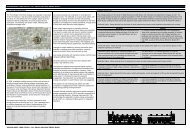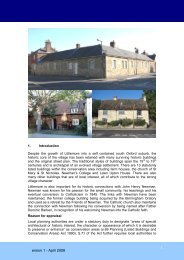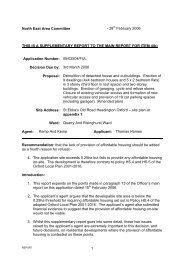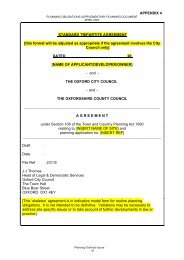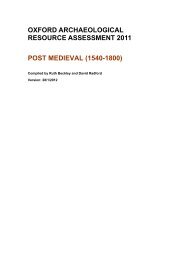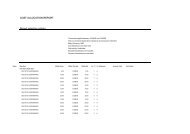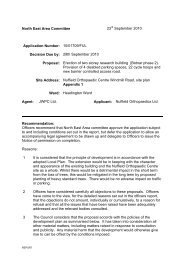Palaeolithic to Mesolithic Oxford (500000 - 4000 BC) - Oxford City ...
Palaeolithic to Mesolithic Oxford (500000 - 4000 BC) - Oxford City ...
Palaeolithic to Mesolithic Oxford (500000 - 4000 BC) - Oxford City ...
Create successful ePaper yourself
Turn your PDF publications into a flip-book with our unique Google optimized e-Paper software.
OXFORD ARCHAEOLOGICAL<br />
RESOURCE ASSESSMENT 2011<br />
PALAEOLITHIC TO MESOLITHIC<br />
Compiled by Ruth Beckley and David Radford with contribution by Francis<br />
Wenban-Smith<br />
Version: 16/9/2012
Introduction ............................................................................................................... 3<br />
The nature of the evidence base.............................................................................3<br />
The <strong>Palaeolithic</strong> in <strong>Oxford</strong>........................................................................................ 5<br />
The dating framework..............................................................................................5<br />
Chronology ..............................................................................................................6<br />
Key characteristics of the <strong>Oxford</strong> landscape in the Lower-Middle <strong>Palaeolithic</strong> .......6<br />
Evidence for in situ <strong>Palaeolithic</strong> sites ....................................................................10<br />
The artefactual evidence ........................................................................................ 11<br />
Lower – Middle <strong>Palaeolithic</strong> evidence ...................................................................11<br />
Upper <strong>Palaeolithic</strong> evidence..................................................................................12<br />
The <strong>Mesolithic</strong> in <strong>Oxford</strong> ........................................................................................ 13<br />
Evidence for in situ activity ....................................................................................13<br />
<strong>Mesolithic</strong> artefacts................................................................................................14<br />
Bibliography ............................................................................................................ 16<br />
Appendix 1: Figures................................................................................................ 21<br />
Figures and Tables<br />
Table 1: Geological formation in the Pleis<strong>to</strong>cene........................................................ 5<br />
Figure 1: Distribution of <strong>Palaeolithic</strong> Finds in <strong>Oxford</strong> District .................................... 21<br />
Figure 2: Distribution of <strong>Mesolithic</strong> artefacts in <strong>Oxford</strong> District.................................. 22<br />
Abbreviations<br />
BP radiocarbon years Before Present (‘present’ is defined as 1950)<br />
LAA <strong>Oxford</strong> Local Authority Area<br />
MIS Marine Iso<strong>to</strong>pe Stage<br />
OHER <strong>Oxford</strong> His<strong>to</strong>ric Environment Record<br />
UAD <strong>Oxford</strong> Urban Archaeological Database<br />
OXFORD ARCHAEOLOGICAL RESOURCE ASSESSMENT- PALAEOLITHIC TO<br />
MESOLITHIC 2
Introduction<br />
This assessment report forms part of the resource assessment stage of the <strong>Oxford</strong><br />
Archaeological Plan for the district. The archaeological assessment aims <strong>to</strong> inform<br />
resource management in planning and development control as well as aid academic<br />
investigation and research. Throughout these reports the ‘city’ will refer <strong>to</strong> the area<br />
covered by the UAD while ‘LAA’ (Local Authority Area) will be used for sites beyond<br />
the his<strong>to</strong>ric centre.<br />
At a regional level available syntheses have been provided by the Solent Thames<br />
Research Frameworks for the Lower <strong>to</strong> Middle <strong>Palaeolithic</strong> (Wenban-Smith et al.<br />
2010) and the Late Upper <strong>Palaeolithic</strong> <strong>to</strong> the <strong>Mesolithic</strong> (Hey et al, 2010). At a county<br />
level, the most recent synthesis is the Solent Thames Research Frameworks<br />
covering the Lower <strong>to</strong> Middle <strong>Palaeolithic</strong> (Hardaker 2007) and the Late Upper<br />
<strong>Palaeolithic</strong> <strong>to</strong> the <strong>Mesolithic</strong> (Hey and Roberts 2008). A comprehensive overview of<br />
the <strong>Palaeolithic</strong> and <strong>Mesolithic</strong> of the Upper Thames has been published in the<br />
Thames Through Time Series (White, Schreve and Morrigi 2011). Previous notable<br />
papers have also been produced in for the Tom Hassall Lectures (Roe 1994; Barclay<br />
1996) and in 1986 (Roe; Case). In addition primary resources from the <strong>Oxford</strong>shire<br />
His<strong>to</strong>ric Environment Record (OHER) and the <strong>Oxford</strong> Urban Archaeological<br />
Database (UAD) have been consulted. Further publications by Roe (1968; 1981) and<br />
Wymer (1968; 1999; Wymer and Bonsall 1977) have also been consulted.<br />
The nature of the evidence base<br />
Unlike later periods the archaeological record for the <strong>Palaeolithic</strong> and <strong>Mesolithic</strong><br />
periods is largely comprised of lithic artefacts and related palaeo-environmental<br />
evidence. There are few, if any, structural remains and artefacts made of organic<br />
materials are extremely rare. The evidence for the Lower and Middle <strong>Palaeolithic</strong><br />
periods has largely been recovered from gravel extraction sites and the distribution is<br />
therefore biased <strong>to</strong>wards the gravel terraces. The number of Upper <strong>Palaeolithic</strong> and<br />
<strong>Mesolithic</strong> artefacts recorded from the district is likely <strong>to</strong> be under-represented at<br />
present as many lithic artefacts identified from museum archives or 19 th century<br />
recorded observation are recorded only as being ‘prehis<strong>to</strong>ric’ and the accompanying<br />
information is often limited.<br />
Key themes<br />
It is difficult based on the current evidence <strong>to</strong> identify any distinct phases of activity in<br />
the <strong>Palaeolithic</strong> and <strong>Mesolithic</strong> periods in the <strong>Oxford</strong> district however the following<br />
key points can be highlighted:<br />
The interglacial Wolvercote Channel Deposit (probably MIS 9) has produced<br />
what appears <strong>to</strong> be an in situ, or little disturbed, <strong>to</strong>ol manufacturing site. This<br />
is currently the oldest and most significant Lower <strong>Palaeolithic</strong> assemblage<br />
known from the district.<br />
Most Lower <strong>Palaeolithic</strong> material from the district consists of stray finds of<br />
rolled artefacts from the Summer<strong>to</strong>wn-Radley Gravel Formation (mainly MIS<br />
7-6). The only major assemblage of material comes from the Cornish’s Pit site<br />
in Iffley<br />
No British Mousterian material has yet been found in the district, and the<br />
reported possible Levallois flake from Davenant Road is probably of Lower<br />
<strong>Palaeolithic</strong> age (Wymer 1968).<br />
Until recently no Upper <strong>Palaeolithic</strong> artefacts were known from the district,<br />
however a few objects of this age were identified in museum collections<br />
OXFORD ARCHAEOLOGICAL RESOURCE ASSESSMENT- PALAEOLITHIC TO<br />
MESOLITHIC 3
during the <strong>Oxford</strong>shire Solent-Thames Research Assessment and illustrate<br />
the potential for material of this age being found in the future (Hey and<br />
Roberts 2008).<br />
The <strong>Mesolithic</strong> is poorly represented in the district at present although this is<br />
likely <strong>to</strong> be due <strong>to</strong> lack of recording rather than an absence of human activity<br />
of this age. There are some stray finds from along the alluvial floodplain<br />
around the city and two larger assemblages from Iffley Fields on the<br />
gravel/muds<strong>to</strong>ne interface and Littlemore Hospital on the Corallian Ridge.<br />
There are also small assemblages from higher ground around the city at<br />
Boars Hill and Sho<strong>to</strong>ver.<br />
Environmental evidence from the <strong>Palaeolithic</strong> and <strong>Mesolithic</strong> has been recorded at<br />
several sites in and around the district from archaeological investigations and<br />
geological surveys (See General Resource Assessment for an overview):<br />
Key sites<br />
Radcliffe Infirmary Geo-archaeological Investigation (Ruddy 2009)<br />
Minchery Farm palaeo-environmental analysis (Parker 1996)<br />
Sidlings Copse palaeo-environmental analysis (Day 1991)<br />
OXFORD ARCHAEOLOGICAL RESOURCE ASSESSMENT- PALAEOLITHIC TO<br />
MESOLITHIC 4
The <strong>Palaeolithic</strong> in <strong>Oxford</strong><br />
The dating framework<br />
The <strong>Palaeolithic</strong> in Britain spans a period from at least 700,000 years ago when the<br />
earliest documented evidence for human activity in the country is recorded until<br />
around 12,000 calibrated years BP at the end of the Pleis<strong>to</strong>cene epoch.<br />
The Pleis<strong>to</strong>cene is the most recent geological epoch and occurred from about 2.6<br />
million years ago until the end of the last glacial period about 12,000 calibrated years<br />
BP. It is known as a period of global climatic instability during which there were a<br />
succession of major warm and cold episodes involving glacial ice advances and<br />
retreats. Although geological deposits relating <strong>to</strong> some of these episodes are found<br />
on land, most knowledge of the complexity of climatic change during the period<br />
comes from the analysis of marine iso<strong>to</strong>pes in deep sea cores. Therefore, in referring<br />
<strong>to</strong> Pleis<strong>to</strong>cene deposits in Britain, including those associated with <strong>Palaeolithic</strong><br />
archaeological remains, it has become common <strong>to</strong> refer <strong>to</strong> global Marine Iso<strong>to</strong>pe<br />
Stage (MIS) as well as local names (Bridgeland 1994). Table 1 summarises the<br />
Pleis<strong>to</strong>cene deposits of the <strong>Oxford</strong> district.<br />
Period ka<br />
(thousand years<br />
ago)<br />
MIS Glacial stage <strong>Oxford</strong> Gravels Industry<br />
12 ka - present 1 Flandrian<br />
(Holocene)<br />
Floodplain <strong>Mesolithic</strong> <strong>to</strong> modern<br />
30-12 ka 2 Devensian<br />
Late Upper <strong>Palaeolithic</strong><br />
60-30 ka 3 (glacial) Northmoor Gravel Early Upper <strong>Palaeolithic</strong><br />
(floodplain gravels) Late Middle <strong>Palaeolithic</strong><br />
(British Mousterian)<br />
110-60 ka 4<br />
5a-c<br />
130-110 ka<br />
5d<br />
5e Ipswichian<br />
Interglacial<br />
Summer<strong>to</strong>wn-Radley<br />
Gravel Formation<br />
190-130 ka 6<br />
Eynsham Gravel (MIS 5e)<br />
245-190 ka<br />
7 Aveley<br />
Interglacial<br />
8<br />
340-300 ka 9<br />
10<br />
Purfleet<br />
interglacial<br />
425-380 ka 11 Hoxnian<br />
Interglacial<br />
12 Anglian<br />
(Glacial)<br />
c. 700-480 ka 13- ‘Cromerian<br />
17 Complex’<br />
Stan<strong>to</strong>n Harcourt Gravel<br />
(MIS 6)<br />
Stan<strong>to</strong>n Harcourt Channel<br />
Deposit (MIS 7)<br />
Wolvercote Gravel<br />
Wolvercote Channel<br />
Deposit (MIS 9)<br />
Hanborough Gravel<br />
Table 1: Pleis<strong>to</strong>cene chronology of the <strong>Oxford</strong> district<br />
Lower/Middle <strong>Palaeolithic</strong><br />
(Handaxe and Levallois<br />
industries)<br />
Lower <strong>Palaeolithic</strong>:<br />
handaxe and flake <strong>to</strong>ol<br />
industries)<br />
Northern Drift group Lower <strong>Palaeolithic</strong>:<br />
handaxe and flake <strong>to</strong>ol<br />
industries)<br />
OXFORD ARCHAEOLOGICAL RESOURCE ASSESSMENT- PALAEOLITHIC TO<br />
MESOLITHIC 5
Chronology<br />
The <strong>Palaeolithic</strong> is traditionally considered <strong>to</strong> consist of three main periods: a Lower<br />
Middle and Upper <strong>Palaeolithic</strong>. Currently the earliest evidence of occupation in Britain<br />
during the Lower <strong>Palaeolithic</strong> dates <strong>to</strong> at least 700,000 years ago in East Anglia<br />
(Bar<strong>to</strong>n 2009, 19). No material of pre-Anglian age (MIS 12 and older) is currently<br />
recorded from the <strong>Oxford</strong> <strong>City</strong> district. Evidence from Suffolk indicates that the<br />
earliest human inhabitants of Britain migrated during warm climatic conditions with<br />
evidence of average summer temperatures of 18-23°C (Bar<strong>to</strong>n 2009 19). The<br />
majority of Lower/Middle <strong>Palaeolithic</strong> evidence for Britain dates <strong>to</strong> MIS 11-6 and most<br />
of the finds from the <strong>Oxford</strong> district date <strong>to</strong> this period. The British Late Middle<br />
<strong>Palaeolithic</strong> British Mousterian industry occurs during the earlier part of MIS 3 from<br />
about 60,000 years ago. As yet there does not seem <strong>to</strong> be evidence for this industry<br />
in the district (Hardaker 2007). The Upper <strong>Palaeolithic</strong> occurs during the later part of<br />
MIS 3 from about 40,000 years ago until the end of the period about 12,000<br />
calibrated years BP. In Britain this period is traditionally divided in<strong>to</strong> an Early Upper<br />
<strong>Palaeolithic</strong> and Late Upper <strong>Palaeolithic</strong>, separated by the extreme cold phase of the<br />
Last Glacial Maximum (LGM) about 21,000-19,000 years ago when humans appear<br />
<strong>to</strong> have been absent from the country. Late Upper <strong>Palaeolithic</strong> recolonisation of<br />
Britain following the LGM started about 16-15,000 calibrated years BP (Bar<strong>to</strong>n 2009).<br />
The Lower <strong>Palaeolithic</strong> context<br />
The lack of finds and features for the Lower-Middle <strong>Palaeolithic</strong> in the Upper Thames<br />
Valley in comparison <strong>to</strong> the Lower Thames Valley is notable and has been<br />
interpreted as being a result of <strong>Oxford</strong>shire being on the upper limit of human<br />
habitation at this time as well as some distance from good sources of flints (Roe<br />
1981; Roe 1994: 2). There are three main areas of Lower/Middle <strong>Palaeolithic</strong> artefact<br />
finds distribution in the county: 1) in the south east around Henley and Dorchester<br />
where the ancient gravel terraces have been particularly prolific 2) the Chiltern slopes<br />
at Benson and fan gravels at Wallingford and 3) the Upper Thames Valley north of<br />
the Goring Gap (Roe 1994: 5). Although the majority of Lower <strong>Palaeolithic</strong> artefacts<br />
in the Upper Thames Valley are recorded from gravel extraction sites there are also a<br />
number of single finds particularly from the <strong>Oxford</strong> area in correlation with the<br />
Summer<strong>to</strong>wn-Radley Gravel Formation. The majority of the artefacts discovered in<br />
<strong>Oxford</strong> are located on or immediately near <strong>to</strong> the terraces and are ‘rolled’ artefacts<br />
likely deposited as a result of fluvial action (Wymer 1968). Truly in-situ artefacts from<br />
the Lower/Middle <strong>Palaeolithic</strong> period in <strong>Oxford</strong>shire are very rare (Hardaker 2007).<br />
However the potential of the Wolvercote Gravel (Wolvercote Channel Deposit - see<br />
below) and the Summer<strong>to</strong>wn-Radley Gravel Formation (e.g. at Stan<strong>to</strong>n Harcourt and<br />
Berinsfield; Hardaker 2007) <strong>to</strong> preserve significant remains has been demonstrated.<br />
Key characteristics of the <strong>Oxford</strong> landscape in the Lower-Middle <strong>Palaeolithic</strong><br />
During the Pleis<strong>to</strong>cene each new glacial phase brought new superficial deposits and<br />
carved new pathways for the rivers and tributaries. The course of the river Thames<br />
itself underwent many changes primarily as a result of these glacial shifts, and it<br />
linked with continental river systems during cooler periods with low sea levels when<br />
England was connected <strong>to</strong> mainland Europe. Recent research has focused on<br />
attempting <strong>to</strong> reconstruct the ancient landscape of the Thames Valley through<br />
defining its relative elevations and the precise course of the river (Maddy et al. 1991;<br />
Bridgeland 1994; Robinson 2003).<br />
The potential for geo-archaeological sampling<br />
Geo-archaeological sampling can provide a stratigraphic framework for<br />
archaeological deposits and interpretations of site formation processes. In the case<br />
of development sites they can also assess the potential impact of development on<br />
OXFORD ARCHAEOLOGICAL RESOURCE ASSESSMENT- PALAEOLITHIC TO<br />
MESOLITHIC 6
<strong>Palaeolithic</strong> deposits and ancient gravel sequences. Geological evidence can help<br />
recreate chronological sequences for the deposition of sediments and locate peat<br />
deposits and palaeo-channels. Environmental sampling for the purpose of collecting<br />
flora and faunal evidence can be useful in understanding past climates at a regional<br />
level and sampling from preserved peats can be especially profitable.<br />
<strong>Oxford</strong> palaeo-channels and geo-archaeological examination of gravel deposits<br />
Palaeo-channels have been identified in a number of investigations across the gravel<br />
terrace e.g. Worcester Place (Parson 2006) however no detailed collation of these<br />
observances has been undertaken. Usually these channels remain undated and are<br />
not subject <strong>to</strong> detailed geo-archaeological analysis because such work is often<br />
difficult <strong>to</strong> justify during small scale developer funded projects.<br />
To date two significant investigations of palaeo-channel and gravel deposits have<br />
taken place in the district,: the examinations of the Wolvercote Channel Deposit<br />
exposed at the Wolvercote Brick Pit from the late 19 th century <strong>to</strong> the 1930’s<br />
(summarised in Wymer 1968) and, more recently, geo-archaeological investigation at<br />
the Radcliffe Infirmary (Radcliffe Observa<strong>to</strong>ry Quarter) site, where extensive<br />
basements are planned as part of a centrepiece development for departments of the<br />
University of <strong>Oxford</strong>. There have also been limited geological descriptions of the<br />
Cornish’s Pit site in Iffley where handaxes were found (Sandford, 1924), and of four<br />
sites in the city where mammoth remains have been found (see below).<br />
The Wolvercote Channel<br />
There has been considerable debate over the geo-archaeological sequence exposed<br />
at the Wolvercote Channel Deposit in North <strong>Oxford</strong>. The artefact assemblage is<br />
recorded from sediments at the base of the interglacial channel in association with<br />
palaeon<strong>to</strong>logical and palaeobotanical remains. The channel was previously attributed<br />
<strong>to</strong> MIS 7 or 5e (summarised in Roe 1994: 13), but is now accepted as being most<br />
likely of MIS 9 age (Bridgeland 1994). The assemblage from the channel is probably<br />
in near primary context and is recognised as being of national importance. However,<br />
the channel deposits have not been exposed since the 1930s, despite several<br />
attempts in the 1980s <strong>to</strong> locate them, and as a result the context and dating remain<br />
uncertain. The location and analysis of the Wolvercote Channel Deposit should be a<br />
research priority for the district.<br />
The Wolvercote Channel in context by Francis Wenban-Smith<br />
The Upper Thames Valley contains various outcrops of Pleis<strong>to</strong>cene terrace deposits,<br />
dating between the end of the last ice age c. 10,000 BP (years Before Present) and<br />
early in the Pleis<strong>to</strong>cene, perhaps as long as 1,000,000 BP. The Wolvercote Channel<br />
site is located on part of Terrace 3, the so-called "Wolvercote Terrace" (British<br />
Geological Survey 1982). The sequence of deposits in this terrace was well-recorded<br />
at the Wolvercote Brick Pit in the late 19 th and early 20 th century (Bell 1904; Sandford<br />
1924). Here, the sequence was seen <strong>to</strong> comprise a widespread gravel deposit c. 2-4<br />
m thick — the "Wolvercote Gravel" — which was overlain, and cut through, by a<br />
channel filled with fine clayey/silty brickearth deposits: the "Wolvercote Channel".<br />
Environmental remains within the Wolvercote Channel fill seem <strong>to</strong> suggest that its<br />
lower parts formed during temperate, probably interglacial conditions; but that its<br />
upper parts formed during climatic deterioration at the end of an interglacial. The date<br />
of the deposit sequence in the Wolvercote Terrace is uncertain, but it is almost<br />
certainly older than deposits in the lower Summer<strong>to</strong>wn-Radley terrace, which<br />
includes deposits dating <strong>to</strong> interglacials at c. 125,000 BP (marine iso<strong>to</strong>pe stage [MIS]<br />
5e) and 200,000 BP (MIS 7), and younger than deposits in the higher Hanborough<br />
terrace, which includes interglacial deposits dating <strong>to</strong> c. 400,000 BP (MIS 11);<br />
therefore the general view (Bridgland 1994) is held that the Wolvercote Terrace<br />
OXFORD ARCHAEOLOGICAL RESOURCE ASSESSMENT- PALAEOLITHIC TO<br />
MESOLITHIC 7
contains deposits dating <strong>to</strong> the period c. 350,000-250,000 BP, covering MIS 10-8.<br />
The Wolvercote Terrace produced an important collection of <strong>Palaeolithic</strong> artefacts<br />
from the lower part of the Wolvercote Channel deposits, recovered from the<br />
Wolvercote Brick Pit when it was open in the late 19 th and early 20 th century,<br />
comprising numerous pointed handaxes with a distinctive plano-convex crosssection,<br />
as well as waste debitage (Roe 1981: 118-128). The mint condition of many<br />
of them suggests they were recovered from an undisturbed occupation horizon<br />
associated with the interglacial conditions at the base of the Wolvercote Channel<br />
sequence. It is also notable that a high proportion of the handaxes are made of flint,<br />
a scarce raw material in the vicinity, and thus indicating targeted collection of the<br />
most suitable raw material, possibly imported from a substantial distance. There are<br />
also reports of occasional finds and faunal remains from higher up the sequence, in<br />
deposits associated with cooler conditions. The Wolvercote Terrace thus contains, in<br />
its Wolvercote Channel facies, rare evidence of undisturbed <strong>Palaeolithic</strong> occupation<br />
in conjunction with mammalian remains and other palaeo-environmental evidence<br />
that can make a significant contribution <strong>to</strong> current research priorities, both regionally<br />
in the Thames basin and the Solent-Thames area (Wenban-Smith et al. 2010), and<br />
nationally in the UK (English Heritage 2008).<br />
Subsequent <strong>to</strong> completion of work in the Wolvercote Brick pit early in the 20 th<br />
century, a number of attempts have been made <strong>to</strong> relocate and reinvestigate the<br />
Wolvercote Channel deposits (Briggs et al. 1985; Bridgland & Harding 1986). These<br />
have, however, been generally unsuccessful. Bridgland and Harding cleared a series<br />
of sections along the railway cutting that runs north-south immediately <strong>to</strong> the east of<br />
the site, but failed <strong>to</strong> find any sign that the Wolvercote Channel deposits extended in<br />
this direction beyond the footprint of the old brick pit. They did, however, find remnant<br />
pockets of the Wolvercote Gravel lying in the <strong>Oxford</strong> Clay bedrock, corresponding<br />
with reports (Pocock 1908: 89) of gravel in "holes in the <strong>Oxford</strong> Clay" on the western<br />
side of the old Wolvercote Brick Pit, <strong>to</strong>wards the railway. It is however uncertain<br />
whether the Wolvercote Channel was genuinely a channel, and thus might be<br />
expected <strong>to</strong> extend as a continuing feature beyond the brick pit, or whether the<br />
"channel" deposits filled intermittent pockets overlying, and in places cutting through,<br />
the Wolvercote Gravel, and thus could be present almost anywhere above mapped<br />
outcrops of Terrace 3.<br />
The Radcliffe Infirmary site<br />
A recent geo-archaeological assessment carried out by Museum of London<br />
Archaeology on samples taken from the Radcliffe Infirmary site was intended <strong>to</strong><br />
examine the potential there for Lower/Middle <strong>Palaeolithic</strong> evidence within the<br />
Summer<strong>to</strong>wn-Radley Gravel Formation (Ruddy 2009: 1). Three phases of braided<br />
river development were recorded, indicated by coarse grained gravel sediments,<br />
interspersed with lower energy channel flow, or episodes of standing water (as<br />
indicated by fine grained sediments). The majority of the gravel beds were initially<br />
thought <strong>to</strong> correlate with the Stan<strong>to</strong>n Harcourt Gravel (MIS 6). However, three OSL<br />
dates obtained from the fine grained material led <strong>to</strong> a reappraisal of the chronology.<br />
Two OSL samples were taken from the fine grained sediment at a height of 60.83m<br />
OD and produced a date of 86.10+/- 9.19 Ka BP, and 76.12 +/- 26.22 Ka BP.<br />
Another OSL date was taken at an elevation of 61m OD and produced a date of<br />
95.66 +/- 13.5 Ka BP. These dates would suggest that a longer chronology of<br />
lithostratigraphy survives on the site than previously believed. The OSL dates fall<br />
within the Early Devensian period leading <strong>to</strong> the association of the upper gravel units<br />
with the Northmoor Gravel member. The lower units may therefore form part of not<br />
only the Stan<strong>to</strong>n Harcourt Gravel (MIS 6) but also the Eynsham Gravel (MIS 5e)<br />
(Braybrooke 2010: 74).<br />
OXFORD ARCHAEOLOGICAL RESOURCE ASSESSMENT- PALAEOLITHIC TO<br />
MESOLITHIC 8
Cornish’s Pit, Iffley<br />
Handaxes were found at Cornish’s gravel pit in Iffley at the end of the 19th and at<br />
start of the 20th centuries. Geological recording was also done in a nearby pit in the<br />
1920s. The artefacts were reported as coming from the base of the Summer<strong>to</strong>wn-<br />
Radley Gravel Formation, close <strong>to</strong> the surface of the underlying <strong>Oxford</strong> Clay.<br />
Pleis<strong>to</strong>cene faunal remains, including woolly rhino, mammoth and horse were<br />
reported from a similar stratigraphic position. The site information has been reviewed<br />
and summarised by Wymer (1968) and Nicholas (2010).<br />
Subsequent re-evaluation of the collection, now held by the Pitt Rivers Museum, has<br />
established that a larger number of flints were collected than previously published. In<br />
2000 the Iffley <strong>to</strong>ols were re-examined by Lee (2001: 104-112). Lee analysed 145<br />
<strong>to</strong>ols from Iffley and agreed with previous assertions that the assemblage was<br />
predominantly Middle Acheulian in date. His analysis summarised that the Iffley <strong>to</strong>ols<br />
tended <strong>to</strong> be shorter than nearby comparable assemblages, such as those from the<br />
Wolvercote Channel assemblage, with the average length of a handaxe being 8.52<br />
cm. Several different <strong>to</strong>ol categories were recorded by Lee including:<br />
Flake <strong>to</strong>ols and debitage [scrapers etc].<br />
Chopping <strong>to</strong>ols, only one quartzite <strong>to</strong>ol is recorded from Iffley (Wolvercote<br />
similarly had a lack of chopping <strong>to</strong>ols)<br />
Handaxes, produced from cores [flakes are removed from the core, which<br />
forms the finished artefact].<br />
A further number of miscellaneous core <strong>to</strong>ols are recorded that do not fall in<strong>to</strong><br />
any particular category.<br />
With the computerization of the Pitt Rivers Museum Accession books (completed by<br />
2002, pers. comm. Alison Petch 2009), and the ongoing cataloguing it has become<br />
clear that the full extent of the Iffley <strong>to</strong>ols was not realised at the time of Lee's work,<br />
and that a further 40 objects await analysis (Nicholas, undated, see web page link<br />
below).<br />
Ashmolean Museum Forecourt, Beaumont Street<br />
A 1994 watching brief during the excavation of the Ashmolean forecourt recovered a<br />
large mammoth tusk from undisturbed gravel of the Summer<strong>to</strong>wn-Radley Formation<br />
at 59.40 OD (Andrews and Mepham 1997). The tusk was found lying flat in a sandy<br />
lens within the finely–bedded gravel, but no geo-archaeological work on the gravels<br />
seems <strong>to</strong> have taken place. An age of about 40,000 years ago (i.e. MIS 3) was<br />
reported for the mammoth, although the grounds for the age estimate are unclear. In<br />
view of the complexity of the gravels at the Radcliffe Infirmary site, not far <strong>to</strong> the<br />
north, a reassessment of the context and age of this find would be useful. The hand<br />
axes are rolled and likely not <strong>to</strong> be in primary context.<br />
Bodleian Extension, Broad Street<br />
Several molars of mammoth were recorded from the Summer<strong>to</strong>wn-Radley gravels at<br />
the site of the Bodleian Extension in 1938 (Sandford 1938: 5). The gravels were<br />
reported as being deeper at this site than then known elsewhere in the city.<br />
Magdalen Grove<br />
In 1922 R T Gunther recorded an in-situ Mammoth tusk exposed by gravel-diggers in<br />
Magdalen Grove within the walled grounds of Magdalen College (Gunther 1924).<br />
Subsequent investigation recorded ‘a charnel-house of elephant-remains’. The<br />
workmen reported that below ‘the shell-bed’ a bear bone was recovered. A drawn<br />
OXFORD ARCHAEOLOGICAL RESOURCE ASSESSMENT- PALAEOLITHIC TO<br />
MESOLITHIC 9
section of the exposure is provided by Sandford (1924)<br />
The English Nature Site of Special Scientific Interest (SSSI) description notes that<br />
fossiliferous sediments underlying the Summer<strong>to</strong>wn-Radley Terrace of the Upper<br />
Thames were exposed by shallow workings in the north-western corner of Magdalen<br />
Grove. These form part of an important and controversial stratigraphy recognised in<br />
the deposits of this terrace, which has been claimed <strong>to</strong> provide evidence for the<br />
existence of a formerly unrecognised inter-glacial stage in the British Late Middle<br />
Pleis<strong>to</strong>cene. The sediments at Magdalen Grove are described as richly fossiliferous,<br />
yielding mammal bones, mollusca and pollen. Although probably representing the<br />
tributary Cherwell, they have been correlated with deposits at Stan<strong>to</strong>n Harcourt, in<br />
the valley of the main river. The fossil assemblage from the Eynsham Gravel<br />
indicates that it was deposited during the penultimate interglacial (correlated with<br />
Oxygen Iso<strong>to</strong>pe Stage 7 of the 'deep sea' record). This interglacial is a recently<br />
identified episode midway between the Hoxnian and Ipswichian Interglacials of the<br />
traditional Pleis<strong>to</strong>cene record. (Natural England SSSI Statement, n.d.)<br />
Evidence for in situ <strong>Palaeolithic</strong> sites<br />
There are currently no demonstrably in-situ sites recorded in the archaeological<br />
record for the <strong>Oxford</strong> <strong>City</strong> district. However the unrolled condition of the Wolvercote<br />
Channel Deposit assemblage indicates that it was probably in a near primary context.<br />
OXFORD ARCHAEOLOGICAL RESOURCE ASSESSMENT- PALAEOLITHIC TO<br />
MESOLITHIC 10
The artefactual evidence<br />
Lower – Middle <strong>Palaeolithic</strong> evidence<br />
Evidence for the Lower and Middle <strong>Palaeolithic</strong> periods in England is rare due <strong>to</strong> the<br />
geological context in which they are found and the great time depth involved. The<br />
evidence for these periods consists almost entirely of lithic artefacts and associated<br />
palaeoenvironmental material. Lower/Middle <strong>Palaeolithic</strong> artefacts are grouped<br />
typological in<strong>to</strong> three modes: Mode 1 simple flake-pebble core assemblages<br />
(‘Clac<strong>to</strong>nian’); Mode 2 assemblages with hand axes (‘Acheulian’); and Mode 3<br />
prepared core and flake technologies (‘Levallois’) (Bar<strong>to</strong>n 2009).. In the <strong>Oxford</strong><br />
district <strong>Palaeolithic</strong> artefacts have been found primarily concentrated in the<br />
Pleis<strong>to</strong>cene deposits of the Upper Thames valley gravel terraces. There is currently<br />
no Mode 3 material identified in the <strong>Oxford</strong> district. Upper <strong>Palaeolithic</strong> typologies are<br />
referred <strong>to</strong> as Mode 4, and there is very little evidence for this period in <strong>Oxford</strong> at<br />
present.<br />
The most significant Lower <strong>Palaeolithic</strong> site in <strong>Oxford</strong> is the Wolvercote Channel<br />
where an assemblage of over 150 flint artefacts was recorded, Cornish’s Pit in Iffley<br />
similarly produced a large number of <strong>Palaeolithic</strong> artefacts, however both sites were<br />
early 20 th century observations of extractive pits and were not subject <strong>to</strong> detailed<br />
recording.<br />
The Wolvercote Channel (OHER 1379)<br />
The Lower <strong>Palaeolithic</strong> archaeology of the Wolvercote Channel Deposit is a research<br />
priority of national importance. The Channel was exposed in the Wolvercote Brick Pit,<br />
which was in operation from the late 19 th century until the 1930s. Artefacts were<br />
collected there by a number of people, and geological observations were recorded by<br />
Bell in 1904 and Sandford in the 1920s (summarised in Wymer 1968). A majority of<br />
the material is currently held by the Pitt Rivers Museum. The assemblage is<br />
distinctive as it contains several hand axes of ‘plano-convex’ form, and also some<br />
material made of quartzite cobbles rather than flint. The Wolvercote material has<br />
been assessed several times in recent decades, but there is still uncertainly about<br />
the dating and geological context of the material as the channel has not been<br />
identified since the 1930s. Other Lower <strong>Palaeolithic</strong> finds from the North<br />
<strong>Oxford</strong>/Wolvercote area have sometimes been included in discussions of the<br />
assemblage from the channel deposit, leading <strong>to</strong> some confusion in the literature<br />
(see Tyledesly 1986 for details).<br />
Cornish’s Pit (OHER 8077)<br />
Until very recently the assemblage from Cornish’s Pit, Iffley, was assumed <strong>to</strong> consist<br />
of about 28 rolled hand axes. Recent work on the artefacts and associated archive at<br />
the Pitt Rivers Museum has identified the original site location, shown that the<br />
assemblage consists of 185 artefacts and confirmed that it was associated with<br />
Pleis<strong>to</strong>cene fauna (Nicholas 2010). This site should now be considered of high<br />
research interest.<br />
Other recent finds of <strong>Palaeolithic</strong> material in the city includes the following.<br />
Excavations within the northeast chapel of Christ Church Cathedral in 1963 (UAD<br />
200) recorded a single flint flake of possible Clac<strong>to</strong>nian type (Sturdy and Case 1963:<br />
91). Two Lower <strong>Palaeolithic</strong> hand axes were recorded as being found at St Ebbe’s<br />
church in 1971 (UAD 243), one from under the foundations of the Saxon church and<br />
the other from the gravel in the Rec<strong>to</strong>ry garden (anon 1972: 239).<br />
A number of <strong>Palaeolithic</strong> finds are included in the <strong>Oxford</strong> His<strong>to</strong>ric Environment<br />
Record (OHER) and the <strong>Oxford</strong> Urban Archaeological Database (UAD). A significant<br />
proportion of the finds are 19 th and early 20th century records with limited<br />
OXFORD ARCHAEOLOGICAL RESOURCE ASSESSMENT- PALAEOLITHIC TO<br />
MESOLITHIC 11
supplementary evidence, and much of the information in the records comes from two<br />
major gazetteers Publisher in the 1960s (Wymer 1968; Roe 1968). The comparable<br />
gazetteer for the Upper <strong>Palaeolithic</strong> period does not identify any material from the<br />
<strong>Oxford</strong> <strong>City</strong> district (Bonsall 1977). However, some specialist re-examination of s<strong>to</strong>ne<br />
<strong>to</strong>ol collections from <strong>Oxford</strong>shire held by the Ashmolean Museum resulted in the<br />
identification of two artefacts of this age and illustrates the potential that further<br />
records exist (Hey and Roberts, 2008). New techniques in identifying assemblages<br />
from non-flint materials such as quartzite have also been developed since the first<br />
catalogues were compiled (MacRae in Hey and Roberts 2008). This also has the<br />
potential <strong>to</strong> identify significant amounts of new data within the archaeological record.<br />
Figure 1 illustrates the distribution of known <strong>Palaeolithic</strong> artefacts across the district.<br />
Upper <strong>Palaeolithic</strong> evidence<br />
Early Upper <strong>Palaeolithic</strong> artefactual evidence is rare at a national level and there are<br />
few finds from <strong>Oxford</strong>shire; a single bifacial leaf point was found in the floodplain<br />
gravels at Sut<strong>to</strong>n Courtenay in the 1990s and a unifacial blade point was dredged up<br />
from the backwater at North Hinksey in 1904 (Hey and Roberts 2010: 2). There is no<br />
further evidence for the Early Upper <strong>Palaeolithic</strong> in <strong>Oxford</strong>shire.<br />
Three main industrial traditions are recognised for the Late Upper <strong>Palaeolithic</strong> in<br />
Britain; and these are represented by Creswellian (c.13,000-12,000 BP), Final<br />
<strong>Palaeolithic</strong> (c.12,000-10,700 BP) and Long Blade or Epipalaeolithic (c. 10,300-9800<br />
BP) industries. Few artefacts from of this age recorded from <strong>Oxford</strong>shire, and there is<br />
only one excavated site (the long blade site at Gatehamp<strong>to</strong>n Farm, Goring) (Hey and<br />
Roberts 2008). At present there are few artefacts of this age known from the <strong>Oxford</strong><br />
<strong>City</strong> district. These consist of two blade end-scrapers (New Hinksey Waterworks and<br />
Bardwell Road) and a lame mâchuré (Headng<strong>to</strong>n Allotments). However, these pieces<br />
were identified in museum collections during the Solent-Thames research<br />
assessment and there is a possibility that more material has been found but remains<br />
unidentified.<br />
OXFORD ARCHAEOLOGICAL RESOURCE ASSESSMENT- PALAEOLITHIC TO<br />
MESOLITHIC 12
The <strong>Mesolithic</strong> in <strong>Oxford</strong><br />
The <strong>Mesolithic</strong> dates from the start of the Holocene approximately 9,600 calibrated<br />
years <strong>BC</strong> (10,000 radiocarbon years BP) <strong>to</strong> the time of the beginning of the Neolithic<br />
period about <strong>4000</strong> calibrated years <strong>BC</strong> (5200 radiocarbon years BP).<br />
In England the period is traditionally divided in<strong>to</strong> an Early (about 9600-6000<br />
calibrated years <strong>BC</strong>) and Later (about 6000-<strong>4000</strong> calibrated years <strong>BC</strong>) facies mainly<br />
based on established typological and technological criteria for lithic artefacts and<br />
well-supported by radiocarbon dating and associated palaeoenvironmental evidence<br />
(Bar<strong>to</strong>n and Roberts 2004). The people at this time were hunter-gatherers who<br />
practiced high logistical mobility within what was an increasingly wooded<br />
environment. <strong>Mesolithic</strong> human activity in inland areas seems <strong>to</strong> have been focused<br />
along rivers valleys, especially during the Later phase (ibid.). Although most of the<br />
evidence for <strong>Mesolithic</strong> activity in England consists of s<strong>to</strong>ne artefacts, there is a high<br />
potential for preservation of organic remains from sites associated with peats, such<br />
as at the classic early <strong>Mesolithic</strong> site at Thatcham in Berkshire (Wymer 1962).<br />
Although the population were mobile hunter-gatherers some occupation evidence<br />
has been recovered from excavations, including the identification of hearths and<br />
activity areas. There are also possible rare examples of structures and s<strong>to</strong>rage pits<br />
from some sites.<br />
The <strong>Mesolithic</strong> in <strong>Oxford</strong>shire is poorly represented with only two sites having been<br />
professionally excavated <strong>to</strong> date: Fyfield and Tubney (Bradley and Hey 1993) and<br />
Nettlebed (Boismier and Mepham 1995). The majority of evidence for the <strong>Mesolithic</strong><br />
in the region comes from stray finds, museum collections, small residual<br />
assemblages noted by commercial archaeological projects, and more substantially<br />
from major fieldwalking surveys in the Upper Thames Valley (Holgate 1986 and the<br />
Chalk Downs (Ford 1987) which indicate a strong distribution of flints across the river<br />
valleys and their slopes.<br />
Of the 54 OHER records for the <strong>Palaeolithic</strong> <strong>to</strong> <strong>Mesolithic</strong> evidence in the district, just<br />
eight could be identified as <strong>Mesolithic</strong> with any certainty and no sites have thus far<br />
been excavated.<br />
Evidence for in situ activity<br />
Whilst no definite in situ <strong>Mesolithic</strong> sites have been archaeologically excavated within<br />
the <strong>Oxford</strong> <strong>City</strong> district <strong>to</strong> date, residual artefacts have been recorded in several<br />
excavations. Figure 2 illustrates the distribution of known <strong>Mesolithic</strong> artefacts in the<br />
district. There seems <strong>to</strong> be a good potential for <strong>Mesolithic</strong> activity on ground above<br />
the alluvial floodplain.<br />
Key characteristics of the <strong>Mesolithic</strong> landscape<br />
The Upper Thames Valley had a tundra landscape during the Younger Dryas cold<br />
phase before the start of the Holocene. Environmental analysis from sites at<br />
Abingdon and Minchery Farm, <strong>Oxford</strong> has provided evidence for a sparsely wooded<br />
landscape populated by only a few species such as beech, willow and poplar (Parker<br />
2000). Birch would have dominated wetter areas along the river and stream corridors<br />
(Moore, 2002, 216). This period also saw the last significant glacial meltwater with<br />
evidence of deeply incised channels forming a complex system of braided rivers and<br />
streams (Robinson and Lambrick 1984). Environmental evidence from sites beyond<br />
the district such as Mingies Ditch and Farmoor <strong>to</strong> the west of <strong>Oxford</strong> indicate that<br />
arctic or sub-arctic conditions prevailed until around the middle of the 10 th millennium<br />
<strong>BC</strong> (Morigi, Schreve and White 2011: 142-2; Robinson and Wilson n.d). At Minges<br />
Ditch a temperate biological assemblage demonstrating the transition <strong>to</strong> a warmer<br />
climate was dated <strong>to</strong> 9380 +- 110 BP (HAR-8366; 10,626=_174 cal BP)(Allen and<br />
OXFORD ARCHAEOLOGICAL RESOURCE ASSESSMENT- PALAEOLITHIC TO<br />
MESOLITHIC 13
Robinson 1993). Within the LAA samples taken during archaeological investigations<br />
at Minchery Farm (Kassam Football Stadium OHER 16787) cover the period from<br />
when the climate was predominately sedges and grasses characteristic of the late<br />
glacial tundra, <strong>to</strong> the present (Parker and Anderson 1996).<br />
As the <strong>Mesolithic</strong> progressed increased woodland provided a dryer climate and<br />
reduced sedimentation (Hey and Roberts 2010). Evidence from peat deposits<br />
discovered during archaeological investigations at St Aldates for example indicated<br />
shallow, standing water during the later <strong>Mesolithic</strong> at about 7200-6900 calibrated<br />
years <strong>BC</strong> (8170±130 BP OxA-4354) (Robinson and Lambrick 1984).<br />
Deposits of peat and tufa (formed through the development of waterlogged ground<br />
where the clays and limes<strong>to</strong>nes meet) can provide environmental evidence for<br />
climate change during the <strong>Palaeolithic</strong> and <strong>Mesolithic</strong>. In the Upper Thames Valley<br />
several ongoing projects carried out by <strong>Oxford</strong> Brookes University and by the<br />
Geological Conservation Review have identified peat and tufa deposits across the<br />
region and have provided environmental sequences from around 10,000 BP <strong>to</strong> the<br />
present (Parker and Anderson 1996: Parker and Goudie 1998; Parker 2000; Day<br />
1990; 1991).<br />
Detailed summaries of two sites within or close <strong>to</strong> <strong>Oxford</strong> have been published; one<br />
outsite the LAA at Sidlings Copse (Day 1990; 1991) covers a period from around ca<br />
9500 yr BP <strong>to</strong> the present and one inside the LAA at Minchery Farm (Parker and<br />
Anderson 1998) from around ca 13,000 yr BP <strong>to</strong> the present. The Minchery Farm<br />
samples indicate the gradual spread of oak, hazel, elm and alder from around ca<br />
10,000 yr BP (ibid.). There areas of shallow water would have gradually become<br />
reedswamp, then marsh before finally becoming woodland (Robinson 2003).<br />
Environmental evidence from sites such as Mingies Ditch and Farmoor indicate a<br />
steady increase in woodland and by the middle of the 6 th millennium <strong>BC</strong>, the region<br />
was likely densely covered by a mixture of deciduous woodland trees (Robinson and<br />
Wilson n.d). For example an organic deposit from a channel of the Windrush at<br />
Minges Ditch produced evidence for dense Alder Woodland dating <strong>to</strong> 5630-5340 cal<br />
<strong>BC</strong> (HAR-8355: 6540+__80BP) (Morigi, Schreve and White 2011: 180). A distinct<br />
decline in woodland is noted in Upper Thames pollen sequences from around ca<br />
5000 yr BP onwards (known as ‘The Elm Decline’) (Parker 2000; Parker et al. 2002).<br />
Evidence for The Elm Decline in the region is often followed by evidence for<br />
agricultural activity in pollen sequences, however the relationship between possible<br />
causes (elm disease, tree clearance for agriculture, climatic change) remain<br />
uncertain (Morigi, Schreve and White 2011: 181-2).<br />
<strong>Mesolithic</strong> artefacts<br />
In has been suggested that <strong>Mesolithic</strong> sites in <strong>Oxford</strong> were primarily located on<br />
sandy geologies such as the Corallian Ridge <strong>to</strong> the east and west of the city (Case<br />
1952-3). At Minchery Farm, Littlemore a small quantity of <strong>Mesolithic</strong> debitage; flakes<br />
with cortex, cores and core rejuvenation flakes indicated that knapping <strong>to</strong>ok place in<br />
the near vicinity (RPS 2001). The recovery of a small amount of late <strong>Mesolithic</strong> or<br />
early Neolithic flintwork at the Manor Ground, London Road, Heading<strong>to</strong>n (Hart 2003)<br />
and at <strong>Oxford</strong> Science Park, Littlemore (Moore 2002: 216) is also consistent with the<br />
documented spread of <strong>Mesolithic</strong> activity from initial sites close <strong>to</strong> the Thames (e.g.<br />
Abingdon) <strong>to</strong> higher ground beyond the immediate environs of the river. Comparable<br />
sites at these higher elevations have been identified at Hatford, Longworth and<br />
Fawler (Case 1986). Elsewhere on the Corallian ridge at Littlemore Hospital a lithic<br />
scatter was discovered comprising of 18 flakes, one axe trimming flake, one crested<br />
blade, one end scraper and one microlith (OHER 16602). Further west a collection of<br />
seven residual flint flakes of likely <strong>Mesolithic</strong> date were recovered during an<br />
OXFORD ARCHAEOLOGICAL RESOURCE ASSESSMENT- PALAEOLITHIC TO<br />
MESOLITHIC 14
evaluation at St Clements Street Car Park located close <strong>to</strong> the River Cherwell<br />
(Garner 2011: 32-3).<br />
Another site of note in east <strong>Oxford</strong> consisted of a scatter of flints found in the early<br />
20 th century from the gravel/muds<strong>to</strong>ne interface near Fairacres Road, Iffley (OHER<br />
3652). The collection of flints from this site is currently held by the Pitt-Rivers<br />
Museum and comprises 35 flakes, one core and eight microliths (Case 1952: 11). On<br />
the Summer<strong>to</strong>wn-Radley Formation gravels in the city the 1960s excavations at<br />
Logic Lane produced bladelet core and end-scraper of <strong>Mesolithic</strong> date as well as a<br />
Bronze Age arrow head and a small group of undiagnostic flints (Radcliffe 1963: 43).<br />
OXFORD ARCHAEOLOGICAL RESOURCE ASSESSMENT- PALAEOLITHIC TO<br />
MESOLITHIC 15
Bibliography<br />
Allen, T G, and Robinson, M A, 1993 The prehis<strong>to</strong>ric landscape and Iron Age<br />
enclosed settlement at Minges Ditch, Harwick-with-Yelford, <strong>Oxford</strong> Archaeology<br />
<strong>Oxford</strong>shire. Thames Valley Landscapes 2<br />
Andrews, P, and Mepham, L, 1997 Medieval and Post-medieval Extra-mural<br />
Settlement on the Site of the Ashmolean Museum Forecourt, Beaumont Street,<br />
<strong>Oxford</strong>. Oxoniensia 62. 185<br />
anon, 1972 Archaeological Notes 1971-72. Oxoniensia 37: 239<br />
Barclay, A, 1996 The Earlier Prehis<strong>to</strong>ry of the <strong>Oxford</strong> Region in the Light of Recent<br />
Research (The Tom Hassall Lecture for 1995). In Oxoniensia 61: 1-21<br />
Bar<strong>to</strong>n, N, 2009 The Late glacial or Latest <strong>Palaeolithic</strong> occupation of Britain. In J<br />
Hunter and I, Rals<strong>to</strong>n. The Archaeology of Britain 2 nd ed. London: Routledge.<br />
Bar<strong>to</strong>n, R N E, and Roberts, A J, 2004 The <strong>Mesolithic</strong> period in England: current<br />
perspectives and new research. In Saville, A. (ed.), <strong>Mesolithic</strong> Scotland and its<br />
Neighbours. The Early Holocene Prehis<strong>to</strong>ry of Scotland, its British and Irish<br />
context, and some Northern European Perspectives”, Edinburgh, Society of<br />
Antiquaries of Scotland. 339-58<br />
Bell, A M, 1904 Implementiferous sections at Wolvercote (<strong>Oxford</strong>shire). Quarterly<br />
Journal of the Geological Society of London 60: 120-132.<br />
Boismier W, and Mepham, L, 1995 Excavation of a <strong>Mesolithic</strong> site at Windmill Hill,<br />
Nettlebed, Oxon. Oxoniensia 60: 1-21<br />
Bradley P and Hey G. 1993 A <strong>Mesolithic</strong> site at New Plantation, Fyfield and Tubney,<br />
<strong>Oxford</strong>shire. Oxoniensia 58: 1-27<br />
Braybrooke, T, 2010 <strong>Oxford</strong> University: Radcliffe Observa<strong>to</strong>ry Quarter (Radcliffe<br />
Observa<strong>to</strong>ry Site) <strong>Oxford</strong>. Post Excavation Assessment. Unpublished report<br />
Bridgeland, D, 1994 The Pleis<strong>to</strong>cene of the Thames. In Bridgeland D (eds).<br />
Quaternary of the Thames Geological Conservation Review Series No. 7.<br />
London: Chapman and Hall.<br />
Bridgland, D ,. & Harding, P, 1986 An attempt <strong>to</strong> locate the "Wolvercote Channel" in the<br />
railway cutting adjacent <strong>to</strong> Wolvercote Brick Pit. Quaternary Newsletter 48: 12-16.<br />
Briggs, D, Coope, G, and Gilbertson, D, 1985 The Chronology and environmental<br />
framework of early man in the Upper Thames Valley. A new model. BAR British<br />
Series 137<br />
British Geological Survey. 1982. Witney. British Geological Survey Geological Map<br />
Sheet 236 (England and Wales). 1:50,000 Series. The Ordnance Survey,<br />
Southamp<strong>to</strong>n.<br />
Case, H, 1952 <strong>Mesolithic</strong> finds in the <strong>Oxford</strong> area. Oxoniensia 17-18: 1-14<br />
Case, H, 1986 The <strong>Mesolithic</strong> and Neolithic in the <strong>Oxford</strong> Region. In Briggs G et al.<br />
The Archaeology of the <strong>Oxford</strong> Region. <strong>Oxford</strong>: <strong>Oxford</strong> University Department for<br />
External Studies. Ch.2<br />
Day, S P, 1990 His<strong>to</strong>ry and Palaeoecology of Woodland of the <strong>Oxford</strong> Region.<br />
Unpublished D Phil thesis. University of <strong>Oxford</strong><br />
Day, S P, 1991 Post-glacial vegetation his<strong>to</strong>ry of the <strong>Oxford</strong> region, New Phy<strong>to</strong>logist<br />
119, 445–70<br />
Dodd, A, 2003 <strong>Oxford</strong> before the University. Thames Valley Landscapes Monograph<br />
OXFORD ARCHAEOLOGICAL RESOURCE ASSESSMENT- PALAEOLITHIC TO<br />
MESOLITHIC 16
17. <strong>Oxford</strong>: <strong>Oxford</strong> Archaeological Unit<br />
English Heritage. 2008. Research and Conservation Framework for the British<br />
<strong>Palaeolithic</strong>. English Heritage, London.<br />
English Nature N.D. SSSI Description Magdalen Grove<br />
Ford, S, 1987 ‘Flint scatters and Prehis<strong>to</strong>ric settlement patterns in South <strong>Oxford</strong>shire<br />
and East Berkshire’, in A G Brown and M R Edmonds (eds), Lithic Analysis and<br />
Later British Prehis<strong>to</strong>ry, BAR 162, <strong>Oxford</strong>, 101–35<br />
Garner, M, 2011 Flint Report in Smith. M P Archaeological evaluation of the St<br />
Clement’s Street car park, <strong>Oxford</strong>. Unpublished Southamp<strong>to</strong>n Archaeology<br />
report.<br />
Gunther, R T, 1924 The Daubeny Labora<strong>to</strong>ry Register 1916-1923 <strong>Oxford</strong> University<br />
Press 374-5<br />
Hardaker, T, 2007 The Lower and Middle <strong>Palaeolithic</strong> of <strong>Oxford</strong>shire. Solent Thames<br />
County Research Framework: <strong>Oxford</strong>shire<br />
Hart, D, 2003 An archaeological excavation at the Manor Ground, London Road,<br />
Heading<strong>to</strong>n, <strong>Oxford</strong>. John Moore Heritage Services. Unpublished Report<br />
Hey, G, and Roberts, A, 2008 <strong>Oxford</strong>shire in the <strong>Mesolithic</strong> and Upper <strong>Palaeolithic</strong>.<br />
Solent Thames Research Framework: <strong>Oxford</strong>shire<br />
Hey, G, (ed) 2010 Later Upper <strong>Palaeolithic</strong> and <strong>Mesolithic</strong> Resource Assessment.<br />
Solent Thames Research Framework: Regional<br />
Holgate, R, 1986 <strong>Mesolithic</strong>, Neolithic and Earlier Bronze Age Settlement Patterns<br />
South West of <strong>Oxford</strong>. In Oxoniensia 51: 1-15<br />
Lee, HW, 2001 A Study of Lower <strong>Palaeolithic</strong> S<strong>to</strong>ne Artefacts from Selected Sites in<br />
the Upper and Middle Thames Valley, with Particular Reference <strong>to</strong> the R. J.<br />
MacRae Collection. <strong>Oxford</strong>: B.A.R (British Series 319)<br />
Maddy, D, Lewis, S G, and Green, C P, 1991 A review of the stratigraphic<br />
significance of the Wolvercote Terrace of the Upper Thames Valley. Proceedings<br />
of the Geologists Association, 102:217-225<br />
Miles, D, 1997 Conflict and Complexity: The Latter Prehis<strong>to</strong>ry of the <strong>Oxford</strong> Region<br />
(The Tom Hassall lecture for 1996) In Oxoniensia 62: 1-21<br />
Milner, N, and Mithen, S, 2009 Hunter-gatherers of the <strong>Mesolithic</strong>. In J Hunter and I<br />
Rals<strong>to</strong>n. The Archaeology of Britain. 2 nd ed. London: Routledge. pp53-72<br />
Moore, J, et al. 2002 Excavations at <strong>Oxford</strong> Science Park, Littlemore, <strong>Oxford</strong>.<br />
Oxoniensia 2001 LXVI , 163-221<br />
Nicholas, M, 2009 Alexander James Montgomerie Bell. England: The Other Within<br />
website, http://england.prm.ox.ac.uk/englishness-Bell-collection.html. Accessed<br />
28/09/2011<br />
Parker, A. and Goudie, A S, 1996 A note on the peat deposits at Minchery Farm,<br />
Littlemore, <strong>Oxford</strong>, and their implications for palaeo-environmental reconstruction.<br />
Proceedings of the Cotswold Naturalists Field Club 41: 1: 129-138<br />
Parker, A, 1998 The distribution and modes of origin of peat and calcareous tufa<br />
deposits in the Upper Thames Valley. Proceedings of the Cotteswold Naturalists<br />
Field Club 42: 2: 230-48<br />
Parker, A, 2000 Biotic Response <strong>to</strong> Late Quaternary global change – the pollen<br />
record: a case study from the Upper Thames Valley, England. In Culver S and<br />
OXFORD ARCHAEOLOGICAL RESOURCE ASSESSMENT- PALAEOLITHIC TO<br />
MESOLITHIC 17
Rawson, P (eds). Biotic Response <strong>to</strong> Global Change: the last 145 million years.<br />
Cambridge: Cambridge University Press<br />
Parker, A G, Goudie, A S, Anderson, D E, Robinson, M A, and Bonsall, C, 2002 A<br />
review of the mid-Holocene elm decline in the British Isles, Progress in Physical<br />
Geography 26, 1-45<br />
Parker, A, and Anderson, D, 1996 A note on the peat deposits at Minchery Farm,<br />
Littlemore, <strong>Oxford</strong>, and their implications for palaeo-environmental reconstruction.<br />
In Proceedings of the Cotswold Naturalists Field Club 41: 1: 129-138<br />
Parson, M, 2006 An Archaeological Field Evaluation at Worcester Place, <strong>Oxford</strong><br />
John Moore Heritage Services. Unpublished report<br />
Parsons, M, 2007 An Archaeological evaluation at Said Business School, <strong>Oxford</strong>.<br />
John Moore Heritage Service. Unpublished Report<br />
Pocock, T I, 1908. The Geology of the Country around <strong>Oxford</strong>. Memoir of the<br />
Geological Survey of Great Britain.<br />
Powell, P, 2005 The Geology of <strong>Oxford</strong>shire. Wimborne: The Dovecote Press Ltd<br />
Radcliffe, F, 1963 Excavations at Logic Lane, <strong>Oxford</strong>. Oxoniensia 1961-62, 38-69<br />
Robinson, M, and Wilson, B, n.d. A survey of environmental archaeology in the South<br />
Midlands. <strong>Oxford</strong><br />
Robinson, M, and Lambrick, G, 1984 Holocene alleviation and hydrology in the<br />
Upper Thames Basin. In Nature 308: 809-814<br />
Roe, D, 1968 A Gazetteer of British Lower and Middle <strong>Palaeolithic</strong> Sites. CBA<br />
Research Report No. 8. London: Council for British Archaeology<br />
Roe, D, 1981 The Lower and Middle <strong>Palaeolithic</strong> Periods in Britain. London:<br />
Routledge<br />
Roe, D. 1986 The <strong>Palaeolithic</strong> Period in the <strong>Oxford</strong> Region. In Briggs G et al. The<br />
Archaeology of the <strong>Oxford</strong> Region. <strong>Oxford</strong>: <strong>Oxford</strong> University Department for<br />
External Studies. Ch. 1<br />
Roe, D, 1994 The <strong>Palaeolithic</strong> Archaeology of the <strong>Oxford</strong> Region (The Tom Hassall<br />
Lecture for 1994). In Oxoniensia 59: 1-17<br />
RPS, 2001 <strong>Oxford</strong> United Football Stadium, Minchery Farm. Archaeological<br />
Assessment Report Unpublished report<br />
Ruddy, M, 2009 <strong>Oxford</strong> University: Radcliffe Observa<strong>to</strong>ry Quarter Geoarchaeological<br />
desk-based assessment. Unpublished Report<br />
Sandford, K S, 1924 The river gravels of the <strong>Oxford</strong> District. Quarterly Journal of the<br />
Geological Society of London 80, 113-79<br />
Sandford, D, 1938 Note on teeth of Elephants from gravels on the site of the<br />
Bodleian Extension. In W Arkell. The Geology of the site of the Bodleian<br />
Extension in Broad Street. Oxoniensia 3: 1-7<br />
Subadra. 2009. Geotechnical and Environmental Site Assessment Report: Woods<strong>to</strong>ck<br />
Connect, Woods<strong>to</strong>ck Road, Wolvercote, Oxon, OX2 8JP. Report BP-09897-CL-001.<br />
Morigi, A, Schreve, D, and White, M, 2011 The Thames Through Time: The<br />
Archaeology of the Gravel Terraces of the Upper and Middle Thames Early<br />
Prehis<strong>to</strong>ry <strong>to</strong> 1500<strong>BC</strong> Part 1 The Ice Ages: palaeogeography, <strong>Palaeolithic</strong><br />
archaeology and Pleis<strong>to</strong>cene environments. <strong>Oxford</strong> Archaeology Thames Valley<br />
OXFORD ARCHAEOLOGICAL RESOURCE ASSESSMENT- PALAEOLITHIC TO<br />
MESOLITHIC 18
Landscapes Monograph No 32<br />
Shilli<strong>to</strong>e, J, 1963 Tusk of mammoth in the flood plain gravels at Wolvercote.<br />
Oxoniensia 28: 93<br />
Sturdy, D, and Case, H, 1963 Archaeological Notes and News: <strong>Oxford</strong>, Christ<br />
Church. Oxoniensia 28: 91<br />
Tyldesley, J, 1986 The Wolvercote Channel hand axe Assemblage. B.A.R. 153.<br />
<strong>Oxford</strong>: B.A.R. British Series<br />
Wenban-Smith, F, et al. 2010 Lower/Middle <strong>Palaeolithic</strong> Resource Assessment in the<br />
Solent-Thames region. Solent Thames Regional Research Framework<br />
White, M, Schreve, D, and Morrigi, A, 2011 The ‘Purfleet’ interglacial and adjacent<br />
cold stages (MIS10-8) in White, M, Schreve, D and Morrigi Thames Through<br />
Time: The Archaeology of the Gravel Terraces of the Upper and Middle Thames:<br />
Early Prehis<strong>to</strong>ry <strong>to</strong> 1500 <strong>BC</strong> Part 1 The Ice Ages. <strong>Oxford</strong> Archaeology Thames<br />
Valley Landscape Monograph No 32<br />
Wymer, J, 1968 Lower <strong>Palaeolithic</strong> Activity in Britain as represented by the Thames<br />
Valley. London: J Baker<br />
Wymer, J, and Bonsall, C, 1977 Gazetteer of <strong>Mesolithic</strong> sites in England and Wales.<br />
CBA Report No.20. London: Council for British Archaeology<br />
Wymer, J, 1999 The Lower <strong>Palaeolithic</strong> Occupation of Britain. Volume I. Salisbury:<br />
Wessex Archaeology and English Heritage<br />
Further resources:<br />
Geology<br />
Geological Conservation Review<br />
Summary descriptions of site evaluation of geological stratification for the county:<br />
http://www.jncc.gov.uk/default.aspx?page=2947)<br />
British Geological Survey Online Maps:<br />
http://maps.bgs.ac.uk/geologyviewer_google/googleviewer.html<br />
Archaeological Evidence<br />
<strong>Oxford</strong> Urban Archaeological Database, <strong>Oxford</strong> <strong>City</strong> Council<br />
A database of archaeological records for the his<strong>to</strong>ric city centre area. For a map of<br />
the area covered by the UAD see visit:<br />
http://www.oxford.gov.uk/PageRender/decP/UrbanArchaeologicalDatabase.htm<br />
To search a version of the database visit:<br />
http://www.heritagegateway.org.uk/gateway/<br />
<strong>Oxford</strong>shire His<strong>to</strong>ric Environment Record, <strong>Oxford</strong>shire County Council<br />
A database of archaeological records for the County of <strong>Oxford</strong>shire. To search the<br />
database visit the Heritage Gateway:<br />
http://www.heritagegateway.org.uk/gateway/<br />
or <strong>Oxford</strong>shire Heritage Search:<br />
http://publicapps.oxfordshire.gov.uk/wps/portal/publicapps/applications/heritage<br />
<strong>Oxford</strong> His<strong>to</strong>ry Centre (formerly the County Records Office)<br />
Holds large collection of his<strong>to</strong>ric maps and his<strong>to</strong>ric documents from the medieval<br />
OXFORD ARCHAEOLOGICAL RESOURCE ASSESSMENT- PALAEOLITHIC TO<br />
MESOLITHIC 19
period <strong>to</strong> the present.<br />
http://www.oxfordshire.gov.uk/cms/public-site/oxfordshire-his<strong>to</strong>ry-centre<br />
Oxoniensia<br />
Archaeological and architectural journal for <strong>Oxford</strong>shire<br />
http://www.oahs.org.uk/oxof.php<br />
Archaeology Data Service.<br />
Holds archive of grey literature by participating archaeological units from c2000<br />
onwards. Also holds complete catalogue of several archaeological journals including<br />
Medieval Archaeology as well as complete archive of CBA publications:<br />
http://ads.ahds.ac.uk/.<br />
Portable Antiquities Scheme<br />
Voluntary scheme recording archaeological objects recorded by members of the<br />
public including those by metal-detec<strong>to</strong>r users<br />
http://www.finds.org.uk/<br />
Museum Archives<br />
The Ashmolean Museum:<br />
http://www.ashmolean.org/<br />
Also for ceramics online see the Ashmolean Potweb:<br />
http://potweb.ashmolean.org/PotChron7g.html<br />
The Pitt Rivers Museum:<br />
http://www.prm.ox.ac.uk/<br />
The Collection of Flints from Iffley have been reviewed by Nicholas, M, (undated).<br />
See http://england.prm.ox.ac.uk/englishness-Iffley-Bell.html (accesssed July 2011)<br />
<strong>Oxford</strong>shire County Museums:<br />
http://www.oxfordshire.gov.uk/cms/public-site/oxfordshire-museum<br />
OXFORD ARCHAEOLOGICAL RESOURCE ASSESSMENT- PALAEOLITHIC TO<br />
MESOLITHIC 20
Appendix 1: Figures<br />
Figure 1: Distribution of Lower/Middle <strong>Palaeolithic</strong> Finds in <strong>Oxford</strong> District<br />
OXFORD ARCHAEOLOGICAL RESOURCE ASSESSMENT- PALAEOLITHIC TO<br />
MESOLITHIC 21
Figure 2: Distribution of <strong>Mesolithic</strong> artefacts in <strong>Oxford</strong> District<br />
OXFORD ARCHAEOLOGICAL RESOURCE ASSESSMENT- PALAEOLITHIC TO<br />
MESOLITHIC 22



